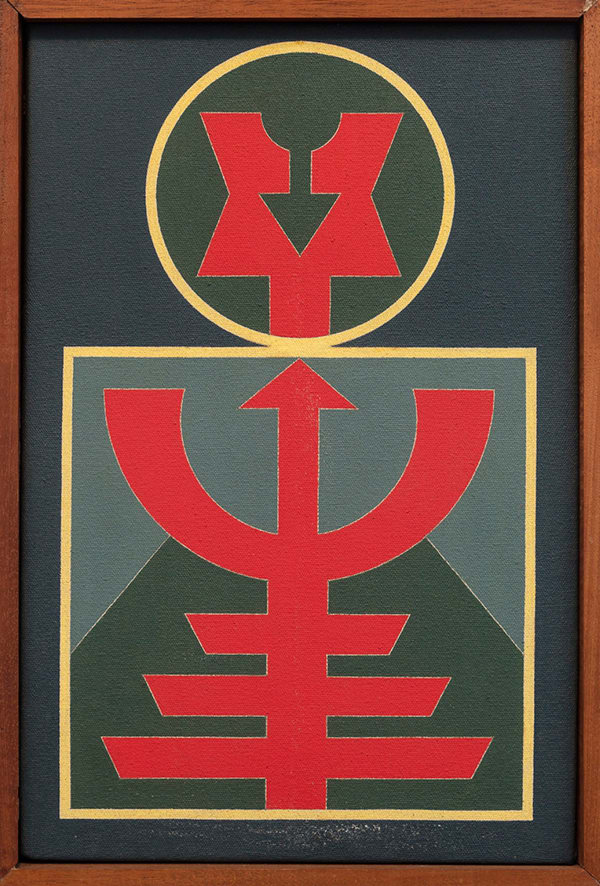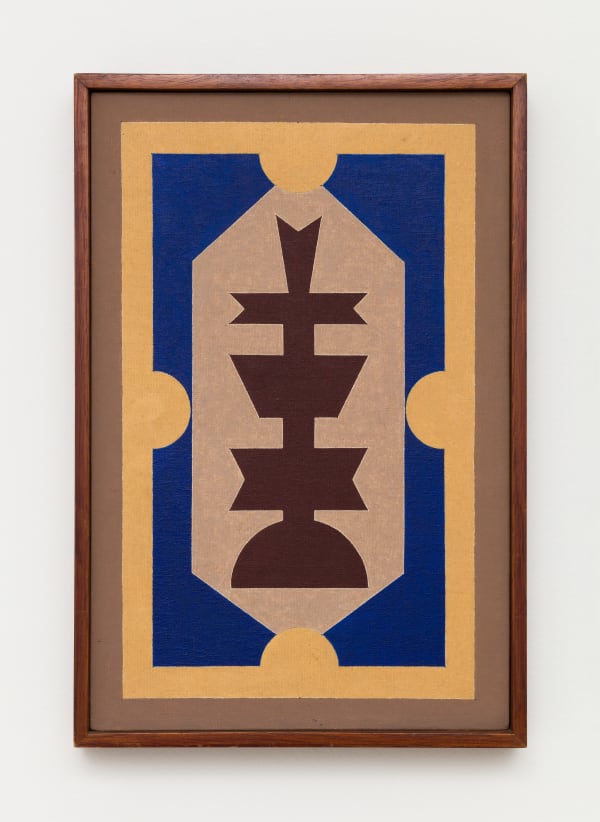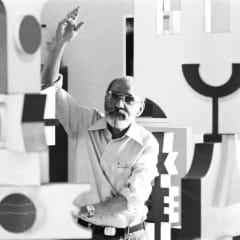Rubem Valentim
Dando seguimento às mostras realizadas nas galerias de São Paulo e Nova York, a Mendes Wood DM Bruxelas tem o prazer de apresentar uma individual das icônicas pinturas e totens do artista brasileiro Rubem Valentim (Salvador, 1922 – São Paulo, 1991). Composta de obras realizadas entre as décadas de 1960 e 1980, a primeira exposição de Valentim na Bélgica reúne abstrações geométricas que entrelaçam o construtivismo europeu com tradições da cultura popular brasileria.
Como pintor autodidata, Valentim iniciou sua produção artística no final dos anos 1940. Focando em seu legado afro-brasileiro em busca de um vernáculo geométrico que ilustrasse a miscigenação cultural brasileira, Valentim recorreu à abstração geométrica para construir composições complexas que redesenharam e reconfiguraram a iconografia brasileira. Nesse processo, o artista transformou as linguagens artísticas de origem europeia, que dominavam boa parte da produção artística do Brasil e do mundo nas décadas de 1950 e 1960 (abstração geométrica, construtivismo e concretismo), ao misturá-las com referências africanas.
A estrutura dos trabalhos de Valentim é organizada e composta por signos abstratos feitos de linhas horizontais e verticais, círculos, cubos e setas. No entanto, ao contrário do discurso purista do modernismo, as formas que compõem as obras de Valentim são reduções geométricas de orixás do Candomblé e da Umbanda. Originalmente trazidos para as Américas por escravizados da África Central e Ocidental, o Candomblé e a Umbanda se desenvolveram concomitantemente à presença e da influência da igreja Católica Romana, instalada no Brasil pelos colonizadores portugueses. A migração forçada vinda da África foi explorada por Valentim sobretudo em seus totens, baseados em esculturas africanas tradicionais e na arte afro-brasileira. Ao integrar esses diferentes conceitos, Valentim criou uma nova linguagem que representa o Brasil e reconhece sua origem na Diáspora Africana.
A obra de Valentim introduz uma interpenetração sutil e precisa entre uma estrutura de base construtiva e a iconografia e o legado coloridos do mágico e religioso universo afro-brasileiro. No entanto, ao contrário de seus contemporâneos concretos, na produção de Valentim, forma e significado estão conectados de maneira intrínseca, sendo sua principal preocupação o conteúdo em vez de “jogos óticos”. Isso fica evidente em seu uso da cor azul, que sugere azulejos portugueses – uma referência à miscigenação forçada imposta pelo colonizador português, ao mesmo tempo que é uma referência a Iemanjá, a orixá dos mares. Da mesma forma, a cor branca traz equilíbrio e harmonia às suas composições, evocando Oxalá, o orixá associado à criação do mundo, à pureza e ao equilíbrio.
Com sua abstração formal, Valentim rejeitou a ideia do afro-brasileiro como uma subcultura ou produto da colonização cultural, como foi muitas vezes descrito, para recompor a materialidade da arte afro-brasileira e da Diáspora Africana. Poderíamos dizer que Valentim é um artista que levou à frente o desejo antropofágico da cultura brasileira: ideia introduzida pelo poeta Oswald de Andrade no final da década de 1920, que propunha a “deglutição” do legado cultural europeu para que fosse, então, digerido e retornado ao mundo na forma de uma arte brasileira genuína.
O trabalho de Rubem Valentim está presente em um grande número de instituições e coleções permanentes, incluindo MoMA, Museu de Arte Moderna de São Paulo, Pinacoteca do Estado de São Paulo, Museu de Arte Moderna do Rio de Janeiro, Museu de Arte Moderna da Bahia, Museu de Arte de Brasília, Museu de Arte de São Paulo Assis Chateaubriand, Museu Afro Brasil, Colección Patricia Phelps de Cisneros, Coleção Adolpho Leirner, Gem Houston, entre outros.
– Thomas Rackowe Cork
-
 Rubem Valentim, Emblema-Relevo, 1980
Rubem Valentim, Emblema-Relevo, 1980 -
 Rubem Valentim, Marca 1Q e 51, 1980
Rubem Valentim, Marca 1Q e 51, 1980 -
 Rubem Valentim, Emblema 1978, 1978
Rubem Valentim, Emblema 1978, 1978 -
 Rubem Valentim, Objeto Emblemático, 1977
Rubem Valentim, Objeto Emblemático, 1977 -
 Rubem Valentim, Emblema 87, 1987-1988
Rubem Valentim, Emblema 87, 1987-1988 -
 Rubem Valentim, Emblema 86, 1986
Rubem Valentim, Emblema 86, 1986 -
 Rubem Valentim, Emblema - 86, 1986
Rubem Valentim, Emblema - 86, 1986 -
 Rubem Valentim, Objeto Místico, 1972
Rubem Valentim, Objeto Místico, 1972 -
 Rubem Valentim, Pintura C, 1967
Rubem Valentim, Pintura C, 1967 -
 Rubem Valentim, Untitled - E 24, 1980
Rubem Valentim, Untitled - E 24, 1980 -
 Rubem Valentim, Emblema Logotipo-Poético, 1975
Rubem Valentim, Emblema Logotipo-Poético, 1975













